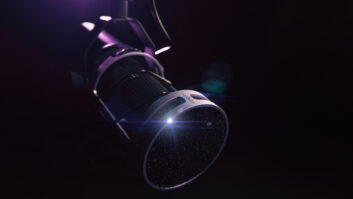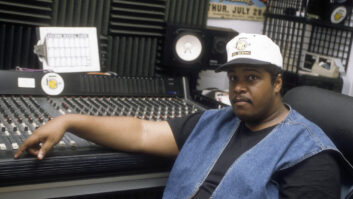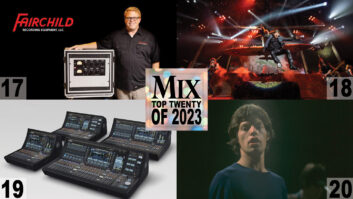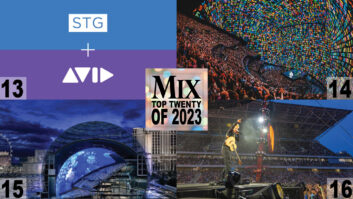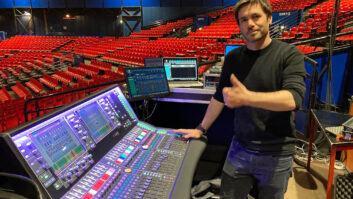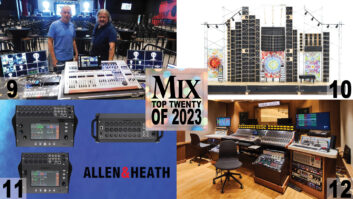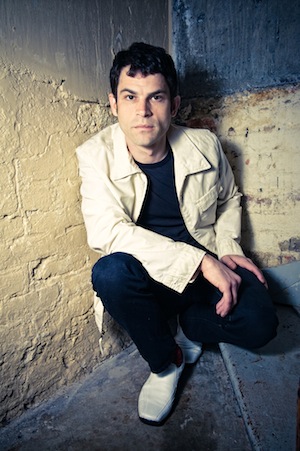
DJ Earworm, the pseudonym of Jordan Roseman, is funny and relaxed, yet underneath, his computer-wiz intensity and composing skills have led to mashup fame. Earworm’s “United State of Pop: Blame It on the Pop” busted out on the Internet in 2009. The YouTube video, now with more than 43 million views, seamlessly blends beats and lyrics from Lady Gaga, Beyoncé, Taylor Swift and other top pop stars. Earworm compiles these annual four-minute pieces from the Top 25 Billboard hits of the year. Mix spoke to Earworm about how the video in 2009 launched his career. “It was time for mashups to explode in general,” he says, adding that 2009 was a tough year economically, and the uplifting message he crafted resonated with people.
Earworm travels the world for live DJ gigs, including the 2012 London Olympics. His recorded mashups have guest-starred at the London Olympics and on E!’s 2013 Live at the Red Carpet pre-Grammy Awards show. At his home in San Francisco, Earworm is developing new software for live DJ technology, and he will appear at SXSW gigs this March.
When you work on the annual “United State of Pop,” do you start with the beat?
It’s a combination of finding the big hit that represents the feeling of the year and other factors, such as, is it mixable? Will it drive the energy for something that represents a year-end summation? You need something that everyone will say, “Oh, that shows now.” I have to transpose all the songs to one key, so I have to consider which key will do the least damage to the bulk of the songs. Then I try to find to find an instrumental that will help drive it.
What software are you using?
I use Ableton Live because it’s so easy to use and can make music happen really fast. It specializes in warping and pitch-shifting music in real time with very high quality, which is great for mashing up.
How do you isolate the tracks?
I try to find the unmixed files from the studio. Whether they’re floating around on the Internet or through connections, if I can get the actual file, that’s number one. Outside of Ableton, I preprocess the audio for extracting the various bits. I use Adobe Audition, specifically the center-channel extractor. It can isolate or suppress frequencies depending on where it pans in the stereo field. I also use Prosoniq sonicWORX Isolate. This program extracts audio based on its fundamental frequency, trying to separate its harmonics from other audio signals.
You’re storing all these files in a massive folder to combine later?
A lot of times I only need a couple of words, so I’ll have separate files with just those words. Then I’ll have other files of a cappella pieces…For the video, I mostly use Final Cut Pro X, which I know will induce snickers, but its native handling of all of my video assets and its XML import functions come in handy.
Is your aesthetic mainstream, or have you moved to that because of what you’re doing right now?
I’ve always been aware of pop, but I didn’t used to be such an active consumer of it. So many people are listening to this mainstream music that if you have something interesting to say, you can hijack pop culture to your own ends. Then you have a much bigger audience. You are saying interesting ideas in the common tongue, so people are seduced into listening to new ideas without realizing it.
Why did you move into mashups as an art form, or musical form?
I thought it was a relatively unexplored art form. I started in late 2003, and most people were doing A vs. B mashups: an a cappella of one song and an instrumental of another.
Like the Grey album [by Danger Mouse, released in 2004]?
Yes. That was the standard, and I didn’t know why people hadn’t taken it much further with a compositional approach. One reason is that it was frowned upon, and it wasn’t considered serious music. It’s still not considered serious music. And there were licensing issues. You can’t monetize it. It doesn’t attract the top talent. I was lucky enough to be in a position where I didn’t care. I didn’t expect to make a living from it.
Then you moved into live DJing.
It was intimidating at first because I’d put myself out online as DJ Earworm without having DJed. Then I started getting gigs, so I had to live up to my pseudonym. That was a bit of a scramble. But that was many years ago and I enjoy it. It gets me out the house [laughs], and pushes me to be in a challenging position, which is very healthy.

